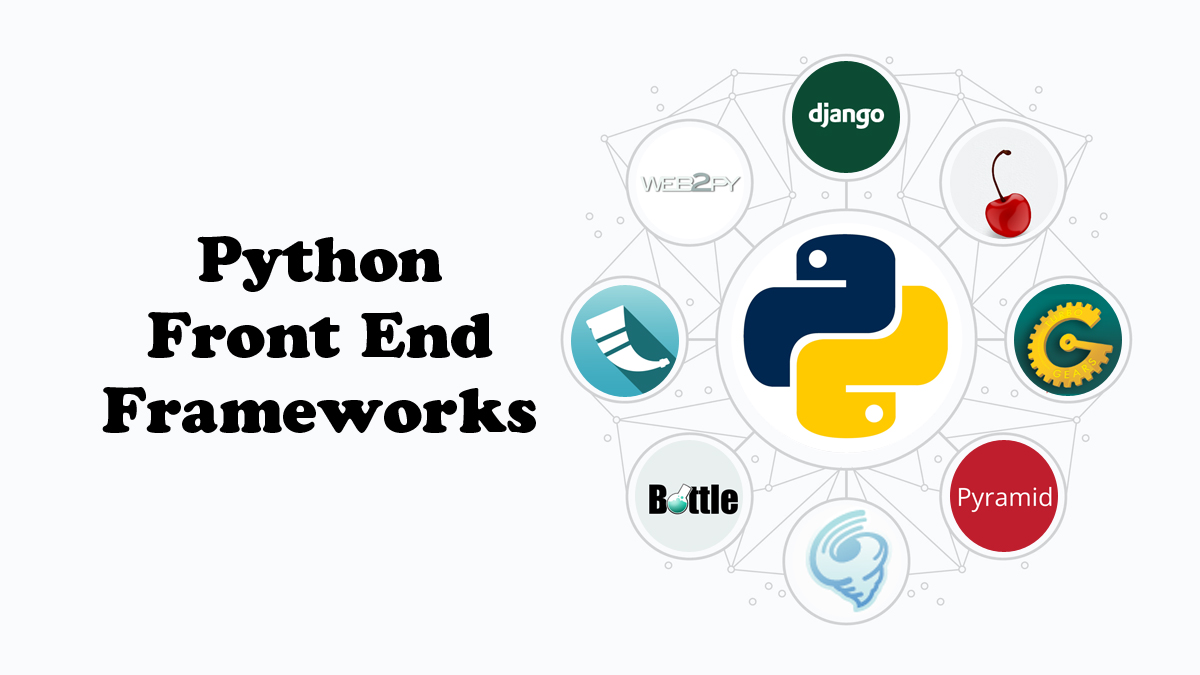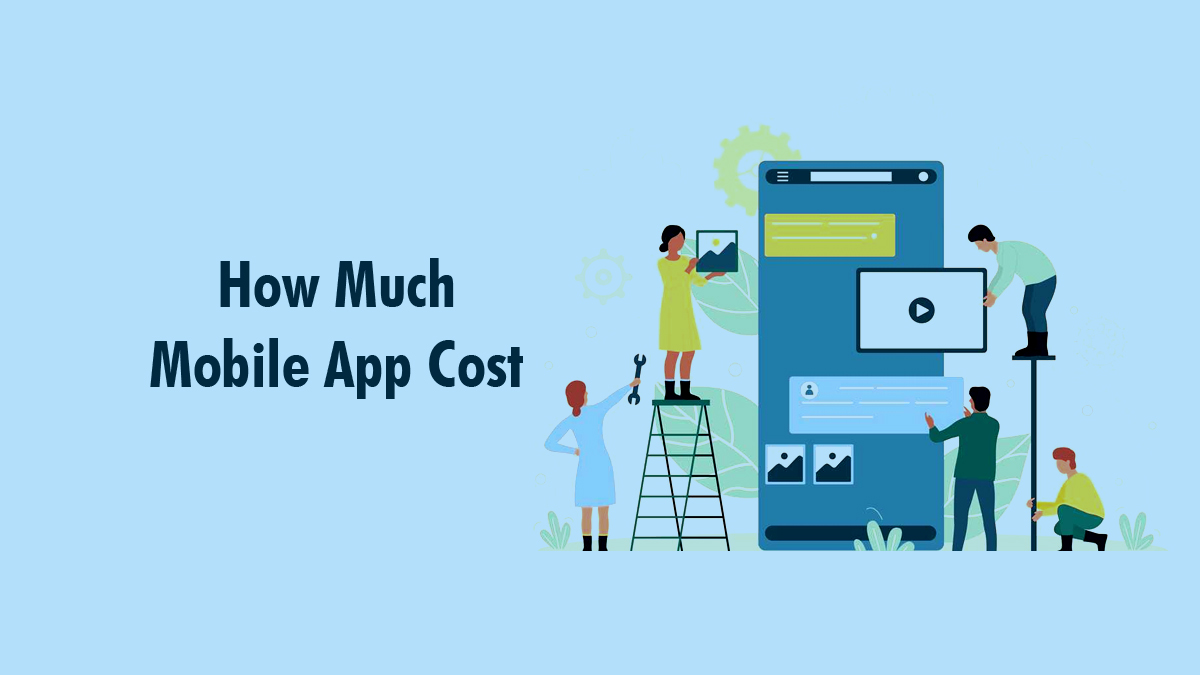Python front-end frameworks are critical in the web development industry. Python, with a 28% market share, is one of the most popular programming languages in the world. It’s worth mentioning that tech behemoths like Google and Netflix rely on Python front-end frameworks for their web development needs.
Python developers frequently use pre-built framework components to minimize expenses and expedite time-to-market. So, if you’re curious about which Python front-end frameworks can improve website speed and reduce time-to-market, keep reading.
Python’s dependability and efficiency will appeal to both newcomer and experienced Python developers. In fact, according to the Popularity of Programming Language Index, it has grown by 8.7% in the previous five years. Furthermore, the TIOBE index makes Python front-end web application development the most popular programming language option worldwide.
However, it is crucial to remember that Python does not have all of the built-in functionality required to accelerate bespoke web application development. That is why many developers rely on Python front-end frameworks to manage the complexities of execution properly. These frameworks provide developers with the tools they need to work on and deliver web applications effortlessly.
In this post, we’ll look at the top Python front end frameworks for 2024 projects that web development firms should consider.
A Front-end development company leverages Python front end frameworks to rapidly build robust and scalable web applications, delivering value to their clients. By utilizing pre-built components and best practices, these frameworks enable quicker time-to-market and lower development costs.
Popular Python Front End Frameworks 2024
Django

Django is a robust Python framework that is both open-source and free. It stands out as an excellent tool for developers who need to rapidly create sophisticated code and applications. Python web developers often find it highly valuable for building high-quality web applications.
Django is a leading Python framework renowned for its effectiveness in developing APIs and web applications. It boasts an impressive track record, with over 12,000 recognized projects built using it. Its success can be attributed to several key features, including an extensive library collection, reduced coding requirements, and the ability to reuse components.
Key Features of Django:
- URL Pattern Definitions: Django simplifies the organization of URLs within your web application, allowing you to define how URLs should be structured. This enhances navigation and user engagement while promoting a well-structured codebase.
- Built-in Authentication System: Django includes a robust built-in authentication system that automates user-related operations like registration, login, password reset, and access control. It addresses common authentication challenges, reducing the development effort required for user authentication and enhancing security.
- Simplified URL Routing System: Despite its extensive capabilities, Django offers a straightforward and efficient URL routing system. This simplifies the mapping of URLs to views, improving user navigation and ensuring easy access to various parts of the application.
- Object-Oriented Database: Django’s database system follows an object-oriented programming paradigm. Instead of writing raw SQL queries, you interact with the database using Python classes and objects. This streamlines data storage and retrieval, resulting in simpler and error-free database operations.
- Automatic Admin Interface: Django features an automatic admin interface that allows developers and administrators to manage application data without writing custom admin panel code. This interface is highly customizable to meet your application’s requirements and supports standard actions like adding, editing, and deleting content.
- Caching Framework: Django incorporates a flexible caching system that stores frequently used data in memory. This enhances the speed of your web application by reducing database queries and calculations, resulting in improved performance and responsiveness.
In a word, Django is an excellent choice for Python developers seeking a comprehensive and efficient framework for web application development. Its array of features significantly simplifies the development process while ensuring high-quality results.
Also Read: Django Vs Ruby on Rails Comparison: Which Framework to Use in 2024
CherryPy
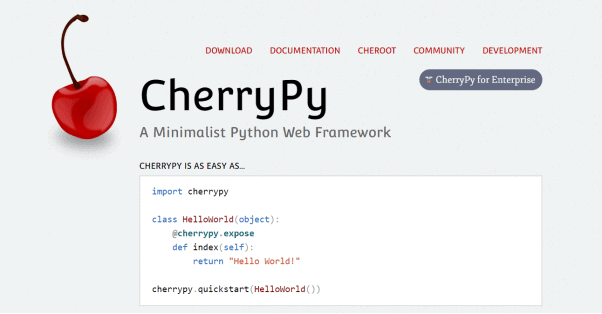
CherryPy is a Python web development framework renowned for its speed, stability, and user-friendly nature. It’s an open-source framework that seamlessly operates with nearly any operating system supporting Python.
One of CherryPy’s standout features is its adaptability. It can be integrated with various technologies for data access and templating. It handles standard web framework tasks such as session management, file uploads, static file serving, cookie management, and more.
What sets CherryPy apart is its approach that enables developers to build web apps just like they would construct any other object-oriented Python program. This methodology results in less code written in less time.
Key Features of CherryPy:
- HTTP/1.1-Compliant Webserver: CherryPy includes an integrated HTTP/1.1-compliant webserver. This ensures that your online apps remain compatible with the latest web technologies and browsers.
- Multi-Server Support: You can concurrently run multiple HTTP servers, even on different ports. This feature is crucial for efficiently managing various components of your web application.
- Python Compatibility: CherryPy is compatible with a range of Python versions, including 2.7+, 3.5+, PyPy, Jython, and Android. Thanks to its wide compatibility, it’s accessible to a vast community of Python developers.
- Built-in Tools: The framework comes equipped with a suite of built-in tools that simplify common web development tasks. These tools address issues such as data encoding, session management, caching, authentication, and serving static content, eliminating the need for third-party libraries or custom code.
- Configuration System: CherryPy boasts a robust configuration system designed for both developers and deployers. It allows you to easily fine-tune your web application’s behavior, making it adaptable to various deployment scenarios.
- Profiling and Testing Support: CherryPy provides built-in support for code profiling, aiding in the identification of performance bottlenecks. It also includes coverage analysis tools to ensure thorough testing of your code, resulting in more stable web applications.
In summary, CherryPy is a flexible Python web development framework with a comprehensive set of features suitable for a wide range of web applications. Its compatibility with Python, coupled with built-in tools and a flexible configuration system, streamlines web development and deployment processes. Additionally, its profiling and testing capabilities enhance the reliability and performance of web apps built with CherryPy.
Pyramid

IT giants such as Mozilla, Yelp, Dropbox, and SurveyMonkey rely on the Pyramid Python web development framework. It’s highly regarded in the industry for its adaptability and straightforward approach, and it is compatible with Python 3.
Pyramid is a top choice among developers, whether they’re working on basic web apps or large-scale projects. Python developers who have experience with it appreciate its transparency and commitment to quality.
Key Features of Pyramid:
- Versatility for Apps of All Sizes: Pyramid is renowned for its ability to handle a wide range of web applications, from simple and straightforward projects to massive and complex ones. Pyramid can adapt to your needs, whether you’re creating a basic blog or a sophisticated e-commerce site.
- URL Mapping with Routes Configuration: Pyramid simplifies URL processing and routing through URL mapping and configuration. Developers can define URL routes through configuration, making it easy to direct incoming requests to the appropriate pages or controllers. This enhances the overall structure of your web application.
- Validation and Generation of HTML Structures: Pyramid includes tools for validating and generating HTML structures. This is particularly important for maintaining clean and compliant code, which is crucial for ensuring that your web app functions smoothly across various browsers and devices.
- Comprehensive Templating and Asset Management: Pyramid offers a sophisticated templating engine that allows developers to create dynamic and data-driven web pages. It also boasts powerful asset management capabilities for handling CSS, JavaScript, and other resources, simplifying the creation of flexible and visually appealing online applications.
- Testing, Support, and Documentation: Pyramid places a strong emphasis on quality and developer-friendliness through testing, support, and documentation. It provides built-in testing support for your application, which is essential for identifying and resolving bugs early in development. Furthermore, Pyramid offers extensive documentation to help developers get started and learn about its capabilities, making it easier to design and manage online applications.
- Flexible Authentication and Authorization: Security is a top priority in web development, and Pyramid addresses this with customizable authentication and permission mechanisms. Developers can implement user authentication and fine-grained access control to ensure that only authorized users can access specific parts of the application.
In a nutshell, Pyramid is a flexible and robust web development framework that offers a wide range of features to streamline the creation of online applications. It is a preferred choice for both small-scale projects and large enterprise-level applications due to its flexibility, comprehensive documentation, and commitment to quality.
Grok
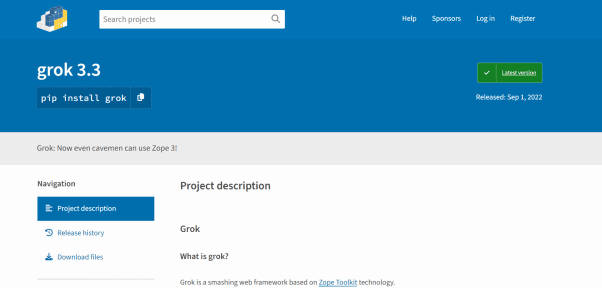
Grok is a web framework based on the Zope toolkit technology (ZTK). It’s designed to provide developers with a simplified development experience by focusing on two fundamental principles:
- Convention over Configuration: Grok simplifies things by establishing logical defaults, so you don’t have to customize everything from the start.
- DRY (Don’t Repeat Yourself): It promotes efficiency by minimizing code repetition.
This open-source framework is aimed at accelerating application development.
Developers using Grok have the freedom to choose from a wide range of networking and standalone libraries based on their project requirements. Grok’s user interface is also similar to that of other full-stack Python frameworks, such as Pylons and TurboGears.
Key Features of Grok:
- Strong Web Application Foundation: Grok provides a solid foundation for web app development. This means it offers a robust framework and a set of tools to assist developers in creating stable and scalable applications as needed.
- Leveraging Zope 3’s Power: Grok utilizes the capabilities of Zope 3, a powerful and versatile framework for developing online applications. This means that Grok inherits and combines the capabilities of Zope 3, transforming it into a robust and feature-rich web framework.
- Integrated Object Database: One of Grok’s critical assets is its integrated object database. This allows developers to easily store and manage data within their web apps while avoiding the complexities of traditional databases, making data management more straightforward.
- Built-in Data Security: Grok recognizes the importance of security in online applications. It includes built-in data security measures to ensure the security of your application’s data, with access restricted and provided to specific individuals or roles as needed.
- Component Architecture: Grok’s architecture is component-based. This approach helps developers break down the program into manageable and reusable components, reducing development complexity and encouraging modular, maintainable code.
- Building Blocks for Customization: Grok provides developers with the necessary building blocks and tools to create unique web apps tailored to specific business requirements. This means you don’t have to start from scratch; Grok offers tools and components to help you get started more quickly.
In summary, Grok is a web framework that combines the features of Zope 3, emphasizes efficiency and convention-based programming, maintains data security, and provides a solid platform for building online applications. It’s a flexible option for developers looking to create sophisticated and adaptable web apps while reducing repetitive tasks and complexities.
TurboGears
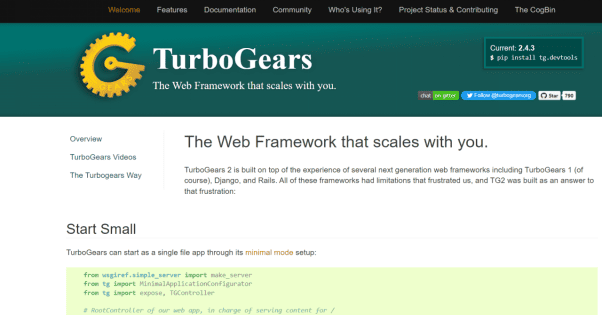
TurboGears is a Python framework specifically designed for creating data-driven, full-stack web applications. It was developed to address the limitations of widely used online and mobile app development frameworks. TurboGears empowers software engineers to kickstart web application development with minimal setup.
Web developers and Python web development organizations can enhance Python website development by leveraging various JavaScript development tools through TurboGears. Compared to existing frameworks, it offers faster online application development by utilizing components like SQLAlchemy, Repoze, WebOb, and Genshi. Additionally, it is compatible with various databases and web servers, including Pylons.
This framework adheres to a Model-View-Controller (MVC) design pattern and includes robust templates, a powerful Object Relational Mapper (ORM), and support for server and browser Ajax. Notable organizations such as Bisque, ShowMeDo, and SourceForge have adopted TurboGears.
Key Features of TurboGears:
- Function Decorators for Feature Implementation: TurboGears employs function decorators, a Python programming tool, to provide multiple capabilities within your web application. This approach simplifies and organizes the code structure.
- Multi-Database Support: TurboGears offers built-in functionality for handling multiple databases. This is particularly useful when your application needs to interface with several database systems simultaneously, providing data storage flexibility.
- Accessible Command-Line Tools: The framework includes user-friendly command-line tools that assist with project setup, database migration, and code compilation. This enhances developer efficiency by streamlining the development process.
- MochiKit JavaScript Library Integration: TurboGears seamlessly integrates the MochiKit JavaScript library, offering a comprehensive set of JavaScript utilities and tools. This integration simplifies the creation of dynamic and interactive user interfaces.
- MVC-Style Architecture and PasteScript Templates: TurboGears adheres to the Model-View-Controller (MVC) design paradigm, separating concerns to improve code maintainability and scalability. Additionally, the framework includes PasteScript templates, pre-configured templates that expedite the creation of typical web application components.
- ToscaWidgets for Frontend-Server Coordination: TurboGears incorporates ToscaWidgets, a feature that facilitates coordination between your application’s frontend (user interface) and server-side components. This simplifies the design, development, and deployment of frontend elements while ensuring smooth interaction with the server.
In essence, TurboGears provides a robust toolkit that allows developers to design full-stack web apps in Python swiftly. It addresses common web development challenges, including database interfacing, frontend-backend coordination, and code management, making it an excellent choice for developing online applications of varying complexities.
Web2Py
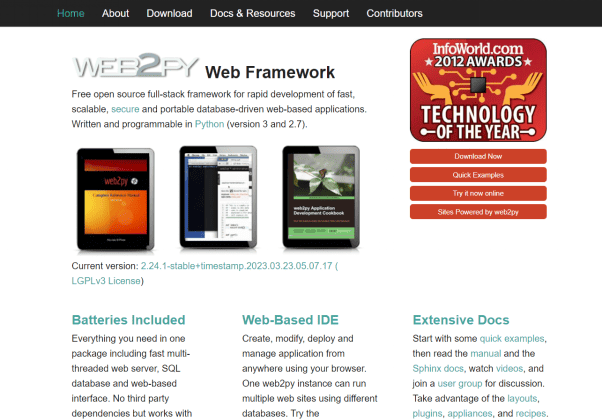
Web2py is a versatile framework that equips programmers with the tools and capabilities required for web application creation and maintenance. Its broad compatibility with various systems, including Windows, Unix/Linux, Mac, Google App Engine, and more, makes it a popular choice among a wide range of users.
Web2py’s primary purpose is to streamline Python app development. It achieves this by offering a web server, SQL database connectivity, and an intuitive online interface. This combination empowers users to swiftly create, edit, deploy, and manage web applications using web browsers.
A standout feature of Web2py is its ticketing system. This system generates a ticket whenever an issue arises, enabling users to track the incident and its current status easily. Additionally, the framework comes with built-in components for handling HTTP requests, responses, sessions, and cookies.
Key Features of Web2py:
- Simplified Development: Web2py follows the “convention over configuration” philosophy, eliminating the need for developers to configure every aspect of their application. This streamlines development by providing sensible defaults and reducing the need for boilerplate code.
- MVC Architecture: Web2py supports the Model-View-Controller (MVC) architecture, aiding developers in organizing their code into three distinct components:
- Model: Represents data and the logic for interfacing with the database.
- View: Manages the presentation layer and determines how data is presented to users.
- Controller: Oversees program logic, handles user requests, and facilitates communication between the Model and View.
- Database Flexibility: Web2py accommodates both relational databases (e.g., MySQL and PostgreSQL) and NoSQL databases (e.g., MongoDB). This flexibility allows developers to choose the database technology that best suits their project’s requirements.
- Web-Based IDE: Web2py features a robust web-based Integrated Development Environment (IDE). It enables users to perform development tasks like modifying application files, running tests, managing files, and reviewing past issue tickets directly from their web browsers. This centralized IDE enhances efficiency.
- Built-in Tools: Web2py includes numerous built-in tools and libraries that assist developers across various aspects of web application development. These technologies handle tasks such as form validation, user authentication, and session management, reducing the reliance on external dependencies.
- Emphasis on Security: Web2py prioritizes web application security. It incorporates tools and processes to address common vulnerabilities, including cross-site scripting (XSS), SQL injection, and cross-site request forgery (CSRF). This proactive approach supports developers in building more secure online applications.
Web2py is a valuable and user-friendly framework that simplifies web development, delivers essential capabilities, and ensures the security of your web applications. Its compatibility with a wide range of platforms makes it a valuable tool for developers in diverse scenarios.
Flask
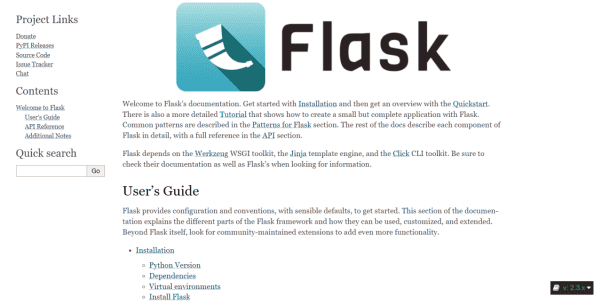
Flask is a Python framework distributed under the BSD license. It draws inspiration from the Sinatra Ruby framework and utilizes the Werkzeug WSGI toolset, along with the Jinja2 template engine. Its primary goal is to facilitate the development of robust web applications.
Developers have the flexibility to customize the Python backend framework to align with their specific requirements. While Flask is adaptable for a wide range of applications, notable companies like LinkedIn and Pinterest have successfully employed it.
Compared to Django, Flask is better suited for smaller and simpler applications, making it an excellent choice for web server development. It is also compatible with Google App Engine and offers built-in unit testing capabilities.
Key Features of Flask:
- Built-in Development Server and Debugger: Flask incorporates a development server and debugger, which is invaluable during the development phase. This server allows developers to locally test their applications locally, facilitating the identification and resolution of bugs.
- RESTful Request Dispatching: Flask excels in supporting RESTful request handling, providing an organized approach to managing HTTP requests. This makes it an excellent choice for developing RESTful APIs and online services, simplifying the routing and handling of HTTP methods such as GET, POST, PUT, and DELETE.
- Integrated Unit Testing Support: Flask promotes best practices by offering integrated unit testing support. Developers can build and execute tests within their Flask applications to ensure code reliability and quality, a crucial aspect of maintaining a stable web application.
- Jinja2 Templating: Flask utilizes Jinja2 as its templating engine, a powerful and flexible template language that enables developers to create dynamic HTML content with ease. Jinja2 offers various tools, including tags, filters, and macros, to expedite template creation.
- WSGI 1.0 Compliance: Flask is fully compliant with the Web Server Gateway Interface (WSGI) 1.0 standard, allowing it to interface seamlessly with a wide array of web servers and platforms, ensuring compatibility and portability.
- Community-Provided Extensions: The Flask community is vibrant and has developed numerous extensions. These extensions are easy to integrate into your Flask application, providing additional functionality. Whether you require authentication, database integration, or other features, there is likely an extension available to meet your needs.
Flask stands out as a versatile and robust web development framework thanks to these features. Whether you’re building a simple web application or a complex RESTful API, Flask offers the necessary tools and framework to streamline your development process effectively.
Also Read: How to Convert HTML to WordPress: Complete Tutorial
Bottle
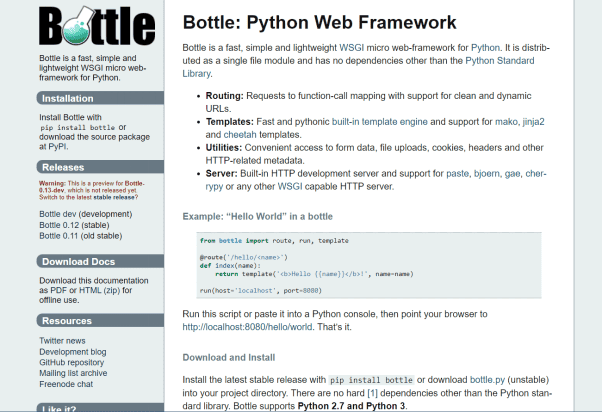
Bottle stands out as one of the best Python web frameworks, notably as a small-scale framework. Its primary objective was to aid in the creation of online APIs, and one of its distinguishing features is its penchant for unifying everything into a single source document. Notably, Bottle does not rely on any dependencies other than the Python Standard Library.
With Bottle, several key components like routing, utilities, and basic abstractions that follow the WSGI standard are included straight out of the box. This implies that, similar to Flask, working with Bottle puts you closer to the underlying components than working with a more comprehensive full-stack framework.
Bottle enables developers to get down to the nitty-gritty of web development. It is not only useful for creating simple personal-use applications but also acts as a fantastic platform for learning about Python frameworks and quick prototyping. In reality, well-known firms such as Netflix have used Bottle for their online interfaces.
Key features of Bottle:
- Clean and Dynamic URL Routing: Bottle simplifies URL routing by providing a straightforward vocabulary for mapping URLs to functions or views. This feature allows you to neatly organize the URLs of your online application, making it easier to manage and navigate across multiple paths.
- Swift and Pythonic Template Engine: Bottle comes with a built-in template engine that is not only fast but also adheres to Python’s coding conventions. This template engine simplifies the process of displaying dynamic content in your online applications, enhancing the overall development experience.
- WSGI Compatibility: Bottle fully supports the Web Server Gateway Interface (WSGI) standard, a familiar interface for Python web applications. This means that your Bottle apps can run on various web servers and deployment platforms that support WSGI, giving you more hosting options.
- Simple Access to HTTP Data: One of Bottle’s merits is its simplicity in handling HTTP-related data, including request parameters, cookies, file uploads, and other metadata. This feature makes it easier for developers to create dynamic web apps by simplifying the process of interacting with client-side data.
- Built-in HTTP Server: Bottle includes an HTTP server that allows you to run your application locally during development without the need for additional server software. While not intended for production use, it is helpful for rapid testing and prototyping.
- Performance Enhancements: Bottle is designed for efficiency and performance improvements. These enhancements can make your web application run faster and handle more concurrent requests, making it suitable for various use cases.
Bottle’s features are tailored for developers who seek a lightweight, Pythonic framework for web app development. Its clear URL routing, integrated template engine, and WSGI compatibility offer development flexibility and convenience. Furthermore, its focus on performance enhancements makes it suitable for both prototyping and production use, depending on your project’s requirements.
Tornado
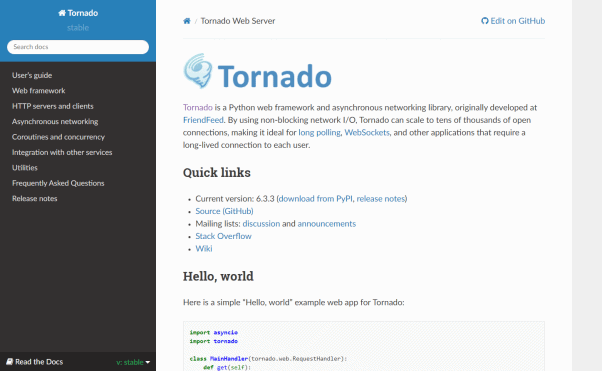
Tornado Framework is a robust Python web framework known for its asynchronous, non-blocking I/O architecture. This means it can handle multiple tasks and connections simultaneously without getting congested.
One of its distinguishing features is its ability to address the C10k challenge successfully. The C10k problem refers to the challenge of handling 10,000 or more concurrent connections to a server. When properly configured, Tornado can gracefully manage this level of concurrency.
Key Features of Tornado:
- Third-party Authentication and Authorization: Tornado allows you to integrate third-party authentication and authorization techniques into your applications seamlessly. This is crucial for ensuring security and controlling user access.
- Real-time Services: Tornado excels at providing real-time services, which is particularly important for applications requiring live updates and interactions, such as chat apps or online gaming platforms.
- Non-blocking HTTP Clients: Tornado’s non-blocking design ensures that HTTP clients can make requests and receive responses without waiting, providing exceptional responsiveness and speed.
- High-quality Output: Tornado is renowned for its high-quality output, ensuring dependable and efficient results whether you’re displaying web pages or delivering data.
- Interpretation and Localization: Tornado supports interpretation and localization, making it easier to design applications catering to users from diverse regions and languages.
- User Authentication Support: User authentication is a critical component of many applications, and Tornado simplifies the process of securing your online applications with its user authentication capabilities.
- Web Templates: Tornado offers web templates, which are pre-designed layouts that can be customized to quickly and consistently build websites. This feature streamlines the development process and helps maintain a consistent design throughout your application.
Tornado is a Python web framework known for its speed, scalability, and rich feature set, making it an excellent choice for developing modern online applications, especially those with real-time requirements and the need to handle a large number of concurrent connections. Its non-blocking I/O architecture and core features empower developers to create robust and responsive web applications.
BlueBream
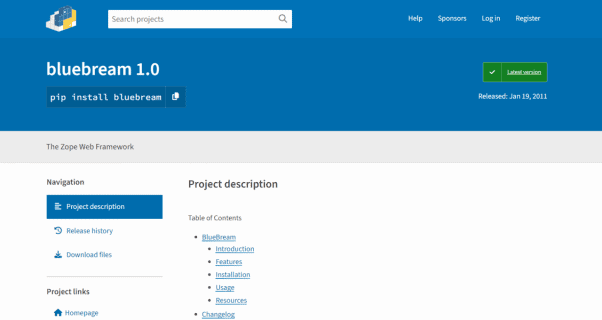
BlueBream is an open-source software toolkit primarily designed for building web applications. It is a valuable tool for website developers as it serves both as a web application framework and a server. Originally developed by the Zope team, it was initially known as Zope 3.
One of BlueBream’s main strengths lies in its ability to manage medium to large web projects effectively. This is achieved by breaking complex applications down into reusable and well-structured components. This modular approach to development enhances efficiency and ease of maintenance.
BlueBream relies on the Zoop Toolkit (ZTK), a rich and experienced toolkit with a strong history. This foundation allows BlueBream to meet the core criteria for constructing robust, reliable, and extensible online applications.
Key Features of BlueBream:
- Compatibility with Python Web Server Gateway Interface (WSGI): BlueBream fully complies with the Python WSGI standard. This interoperability enables BlueBream applications to work seamlessly with various web servers, simplifying deployment and hosting processes.
- Testing Frameworks: BlueBream offers comprehensive testing frameworks, including unit testing and functional testing features. Unit testing ensures the correctness of individual components or functions within your program, while functional testing evaluates the overall performance of your web application. These testing tools are essential for ensuring the reliability and quality of your software.
- Security Mechanism: BlueBream provides a robust security mechanism for implementing essential security measures in your web applications. In the realm of web development, security is paramount to protect against various threats and vulnerabilities. BlueBream equips you with the necessary tools and best practices to fortify your web applications and safeguard your data.
- XHTML-Compliant Templates: Complying with web standards when designing web applications is crucial. BlueBream supports the creation of web templates using an XHTML-compliant language. This ensures that your web pages are well-structured and compatible with modern web browsers, resulting in an improved user experience and accessibility.
- Form Generation Tool: Collecting user input is a fundamental aspect of web application development. BlueBream includes a handy tool for automatically generating forms. This streamlines the creation of online forms, saving you time and effort when developing interactive user interfaces.
- Zope Component Architecture (ZCA): BlueBream adopts the Zope Component Architecture as a robust design pattern. It promotes modularity and reusability by facilitating the separation of concerns in your web applications. By breaking down your program into reusable components, ZCA greatly enhances the manageability and extensibility of your software. This feature is particularly beneficial for handling large web projects.
In summary, BlueBream offers a comprehensive range of functionality to meet the needs of web developers. It is a flexible framework for constructing robust and secure web applications, thanks to its adherence to industry standards, testing capabilities, security features, support for structured templates, and form generation tools.
Furthermore, the Zope Component Architecture makes BlueBream a suitable choice for medium to large-scale web development projects, promoting best practices in software architecture.
Quixote
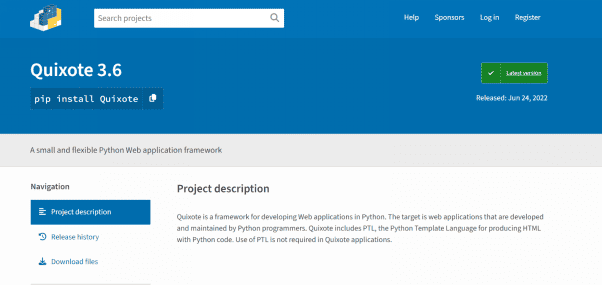
The Quixote framework is designed for Python web application development, with a strong focus on flexibility and performance optimization.
Quixote applications are built using traditional technology. If you’re a Python developer looking to venture into the realm of “real programming languages,” Quixote might be an excellent choice. Python classes and methods handle web page formatting within this framework.
There are three major versions of Quixote. While Versions 1 and 2 share some similarities, they are not identical. Version 1 is no longer supported, whereas both Version 2 and Version 3 require Python 3 and are widely used on public websites.
Key Features of Quixote:
- Simple and Flexible Design with Session Management API: Quixote is renowned for its straightforward and extensible architecture, featuring a Session Management API. This API simplifies user session and data management across multiple interactions with your web application, streamlining development and enhancing the user experience.
- Function Library for HTML Form Development: Quixote includes a function library designed to assist developers in creating and handling HTML forms. This library automates the process of managing user input and form submissions, saving time and effort.
- HTML Templates in Python-like Syntax: Quixote stands out with its support for HTML templates written in a Python-like syntax. This means you can generate dynamic web pages using familiar Python coding techniques, making web development more accessible for Python developers.
- Compatibility with Various Web Servers: Quixote boasts compatibility with a wide range of web servers that utilize the Common Gateway Interface (CGI) or Fast CGI. This adaptability allows you to host your Quixote-based applications on various platforms.
- Support for Apache’s mod_python: For those opting for Apache as their web server, Quixote provides mod_python support. This facilitates seamless integration with Apache, leveraging its performance and features.
- Support for the Simple Common Gateway Interface (SCGI) Protocol: Quixote also extends support to the SCGI protocol. SCGI is a lightweight protocol that enables communication between web servers and application processes. The inclusion of SCGI support enhances Quixote’s versatility in terms of deployment options.
In summary, Quixote caters to developers seeking simplicity and flexibility in Python web application development. It equips you with tools for managing sessions, efficiently handling HTML forms, and generating HTML templates using Python-like syntax. Moreover, its compatibility with various web servers, including Apache, and support for the SCGI protocol make it an adaptable choice for developing online applications.
Conclusion
To summarize, web development in 2024 offers a diverse array of Python frameworks tailored to various needs and preferences. In this post, we’ve reviewed the top 11 Python frameworks, highlighting the rich diversity and innovation within the Python community. Whether you prioritize speed, scalability, or simplicity, there’s a framework suited for your project.
Exploring these frameworks as you dive into web development in 2024 will enable you to build dynamic, feature-rich, and efficient online applications while staying up-to-date with the latest industry trends and technologies. Remember to continue experimenting, learning, and adapting to remain at the forefront of web development in the coming years.
FAQs
Why should you consider using Python for web development?
Python is a widely adopted and versatile programming language, renowned for its accessibility and simplicity. Employing Python for web development enables developers to craft robust and scalable online applications, making it a popular choice for numerous projects.
Which Python web framework is best suited for beginners?
Due to its simplicity and minimalist approach, Flask is often recommended for newcomers. It’s easy to learn and well-suited for small to medium-sized projects.
Is it possible to utilize multiple Python web frameworks within a single project?
While it’s technically possible to employ multiple frameworks within a single project, it’s not a common practice. Each framework is tailored to specific use cases, so choosing one that aligns with your project’s requirements is generally more efficient.
How should you go about selecting the most suitable Python framework for your web development project?
The choice of a Python web framework depends on factors such as project complexity, your familiarity with the framework, specific project requirements, and community support. To make an informed decision, thoroughly research the advantages and disadvantages of each framework.

